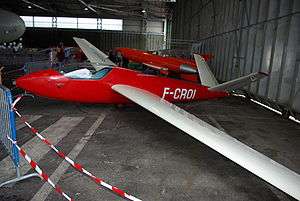Fouga CM.8
| CM.8 | |
|---|---|
 | |
| Role | High-performance sailplane |
| Manufacturer | Fouga |
| Designer | Robert Castello |
| First flight | June 1949 |
| Variants | Fouga CM.88 |
The Fouga CM.8 or Castel-Mauboussin CM.8 was a French sailplane of the 1950s, most notable in retrospect due to its place in the development of the Fouga Magister jet trainer.
Design and development
The CM.8 was a single-seat aircraft of conventional sailplane design and designed for aerobatics. Two prototypes were built: the CM.8/13, with a 13-metre wingspan and a conventional empennage, and the CM.8/15 with a 15-metre wingspan and a V-tail.
The pleasing performance of these aircraft led to experiments with mounting a small turbojet on the dorsal fuselage, exhausting between the tail fins. The first of these flew on 14 July 1949, powered by a Turbomeca Piméné. Designated the CM.8R this combined the 13-metre wing of the CM.8/13 with the tail of the CM.8/15. Two examples were built, and as experiments progressed in the 1950s, they were fitted with increasingly powerful engines, and increasingly shorter wingspans. A twin-fuselage example was also built as the CM.88 as an engine testbed.
Variants
- Fouga CM.8
- Fouga CM.8 Acro
- Fouga CM.8/13
- Fouga CM.8/15
- Fouga CM.8/13 Sylphe démotorisé
- Fouga CM.8 R13 Cyclone
- Fouga CM.8 R13 Sylphe II
- Fouga CM.8 R13 Sylphe III
- Fouga CM.8 R9.8 Cyclope I
- Fouga CM.8 R9.8 Cyclope II
- Fouga CM.8 R8.3 Midget
Specifications (CM.8/13)
General characteristics
- Crew: One pilot
- Length: 6.55 m (21 ft 6 in)
- Wingspan: 13.00 m (42 ft 8 in)
- Height: 1.95 m (6 ft 5 in)
- Wing area: 13 m2 (140 ft2)
- Aspect ratio: 13
- Empty weight: 247 kg (545 lb)
- Gross weight: 330 kg (728 lb)
Performance
- Rate of sink: 1.1 m/s (216 ft/min)
See also
- Related lists
References
| Wikimedia Commons has media related to Fouga CM.8. |
- Bridgman, Leonard (1951). Jane's All The World's Aircraft 1951–52. London: Sampson Low, Marston & Company, Ltd.
- Taylor, Michael J. H. (1989). Jane's Encyclopedia of Aviation. London: Studio Editions. p. 239.
- Planeurs et Avions